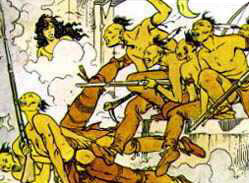 Another Stereotype of the Month entry:
Another Stereotype of the Month entry:
 Another Stereotype of the Month entry:
Another Stereotype of the Month entry:
"A city full of tribes and war chiefs"
From the New York Times:
December 20, 2002, Friday
MOVIES, PERFORMING ARTS/WEEKEND DESK
FILM REVIEW; To Feel A City Seethe
By A. O. SCOTT
"GANGS OF NEW YORK," Martin Scorsese's brutal, flawed and indelible epic of 19th-century urban criminality, begins in a mud-walled, torchlighted cavern, where a group of warriors prepare for battle, arming themselves with clubs and blades and armoring themselves in motley leather and cloth. Though this is Lower Manhattan in 1846, it might as well be the Middle Ages or the time of Gilgamesh: these warlike rituals have an archaic, archetypal feeling.
And the participants are aware of this. As the members of various colorfully named Irish gangs emerge into the winter daylight of Paradise Square (a place long since given over to high-rises and resurrected here on the grounds of the vast Cinecittą studio complex in Rome), their native-born Protestant enemies greet them with an invocation of "the ancient laws of combat." The ensuing melee turns the new-fallen snow pink with blood and claims the life of Priest Vallon (Liam Neeson), an Irish gang chieftain whose young son witnesses the carnage.
Sixteen years later, the boy, whose name is Amsterdam, has grown into Leonardo DiCaprio, his wide, implacable face framed by lank hair and a wispy Van Dyke. He returns from a long stint in the Hell Gate Reformatory to his old neighborhood, the Five Points, and finds it ruled by his father's killer, Bill Cutting (Daniel Day-Lewis), known as the Butcher, a swaggering monster who has turned the anniversary of Priest's death into a local holiday.
Like a figure out of Jacobean theater or a Dumas novel, Amsterdam is consumed by the need for revenge. With the help of a boyhood friend (Henry Thomas), he infiltrates the Butcher's inner circle, becoming a surrogate son to the man who assassinated his father and who now, in accordance with those ancient laws, venerates Priest's memory.
The New York evoked in Amsterdam's voice-over is "a city full of tribes and war chiefs," whose streets are far meaner than any Mr. Scorsese has contemplated before. The Butcher has formed an alliance of convenience with Boss Tweed (Jim Broadbent), the kingpin of Tammany Hall, and together they administer an empire of graft, extortion and larceny that would put any 20th-century movie gangster or political boss to shame. Rival fire companies turn burning buildings into sites of rioting and plunder; crowds gather to witness hangings, bare-knuckled boxing contests and displays of knife throwing.
As new immigrants, from Ireland and elsewhere, pour off the ships in New York harbor, they are mustered into Tweed's Democratic Party and then, since they lack the $300 necessary to buy their way out, into the Union Army. Occasionally a detachment of reform-minded swells will tour the Points, availing themselves of the perennial privileges of squeamish titillation and easy moral superiority. This anarchic inferno is, in Amsterdam's words, not so much a city as "a cauldron in which a great city might be forged."
And in recreating it, Mr. Scorsese has made a near-great movie. His interest in violence, both random and organized, is matched by his love of street-level spectacle. His Old New York is a gaudy multiethnic carnival of misrule, music and impromptu theater, a Breughel painting come to life. Though the details of this lawless, teeming, vibrant milieu may be unfamiliar, we nonetheless instinctively recognize it, from the 19th-century novels of Dickens and Zola, from samurai movies and American westerns and from some of this director's previous films.
Most notably in "Mean Streets, "Goodfellas," "The Age of Innocence" and "Casino," Mr. Scorsese has functioned as a kind of romantic visual anthropologist, fascinated by tribal lore and language, by half-acknowledged codes of honor and retribution and by the boundaries between loyalty and vengeance, between courtesy and violence, that underlie a given social order.
Rob's comment
The idea that "primitive" tribes were bloody, savage, and warlike isn't born out by the facts. Many Indian tribes were peaceful, for example. Meanwhile, the greatest slaughters in history happened in the 20th century, after humanity supposedly reached the pinnacle of civilization.
Related links
Uncivilized Indians
Savage Indians
|
. . . |

|
All material © copyright its original owners, except where noted.
Original text and pictures © copyright 2007 by Robert Schmidt.
Copyrighted material is posted under the Fair Use provision of the Copyright Act,
which allows copying for nonprofit educational uses including criticism and commentary.
Comments sent to the publisher become the property of Blue Corn Comics
and may be used in other postings without permission.